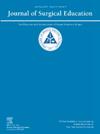Navigating the Path to Surgery: A Systematic Review of Early Surgical Exposure Programs for Preclerkship Medical Students in North America
IF 2.1
3区 医学
Q1 EDUCATION, SCIENTIFIC DISCIPLINES
引用次数: 0
Abstract
Objective
To review the structure, outcomes, and impact of early surgical exposure programs for preclerkship medical students in North America, and to evaluate their role in influencing specialty choice, surgical skill development, and professional engagement.
Design
Systematic review conducted according to PRISMA guidelines, with a preregistered protocol (PROSPERO: CRD42024588099). Data were synthesized narratively due to heterogeneity in study designs and outcomes.
Setting
Studies were conducted primarily at single institutions across the United States and Canada, typically within academic medical centers offering undergraduate medical education.
Participants
Fourteen studies met inclusion criteria, comprising preclerkship medical students enrolled in accredited North American medical schools. Inclusion required programs to be at least 2 days in duration and contain a minimum of 2 educational components (e.g., mentorship, operating room shadowing, procedural skills training, or simulation).
Results
Participation in early surgical exposure programs was associated with increased interest in surgical careers (8/12 studies), improved perceptions of surgery, and greater preparedness and performance during surgical clerkships. Mentorship emerged as a key factor influencing professional engagement. Technical competence and confidence improved across multiple surgical skills (e.g., suturing, knot-tying, OR familiarity). Students consistently reported high satisfaction with the early surgical exposure programs, especially when engaged in hands-on activities.
Conclusions
Early surgical exposure programs offer educational and professional benefits, including enhanced surgical interest, skill development, and mentorship. These findings support broader integration of such programs into undergraduate curricula to inform career decision-making and address workforce needs in surgery.
导航到外科之路:一个系统的早期手术暴露计划在北美的见习医学院学生。
目的:回顾北美实习医学生早期手术暴露计划的结构、结果和影响,并评估其在影响专业选择、外科技能发展和专业参与方面的作用。设计:根据PRISMA指南进行系统评价,采用预注册方案(PROSPERO: CRD42024588099)。由于研究设计和结果的异质性,数据采用叙述性合成。环境:研究主要在美国和加拿大的单一机构进行,通常是在提供本科医学教育的学术医学中心。参与者:14项研究符合纳入标准,包括在认可的北美医学院注册的实习前医学院学生。入选要求项目持续时间至少为2天,并包含至少2个教育组成部分(例如,指导、手术室实习、程序技能培训或模拟)。结果:参与早期手术暴露计划与增加对外科职业的兴趣(8/12项研究),提高对手术的认识以及在外科见习期间更好的准备和表现有关。师徒关系成为影响职业投入的关键因素。多种手术技能(如缝合、打结或熟悉程度)的技术能力和信心得到提高。学生们一致报告了对早期手术暴露计划的高满意度,特别是在从事动手活动时。结论:早期手术暴露计划提供教育和专业利益,包括提高手术兴趣,技能发展和指导。这些发现支持将此类课程更广泛地整合到本科课程中,为职业决策提供信息,并满足外科工作人员的需求。
本文章由计算机程序翻译,如有差异,请以英文原文为准。
求助全文
约1分钟内获得全文
求助全文
来源期刊

Journal of Surgical Education
EDUCATION, SCIENTIFIC DISCIPLINES-SURGERY
CiteScore
5.60
自引率
10.30%
发文量
261
审稿时长
48 days
期刊介绍:
The Journal of Surgical Education (JSE) is dedicated to advancing the field of surgical education through original research. The journal publishes research articles in all surgical disciplines on topics relative to the education of surgical students, residents, and fellows, as well as practicing surgeons. Our readers look to JSE for timely, innovative research findings from the international surgical education community. As the official journal of the Association of Program Directors in Surgery (APDS), JSE publishes the proceedings of the annual APDS meeting held during Surgery Education Week.
 求助内容:
求助内容: 应助结果提醒方式:
应助结果提醒方式:


